10 Tall Weeds With Thick Stalks That Might Invade Your Garden
Tall weeds with thick stalks are invading your yard or garden and don’t know what kind of plants are those? I made a list of plants with thick and tall stems to help you identify the intruders.
A few days ago, my friend has asked me if I can help him identify a plant with a thick stalk and large leaves that was growing in a corner of his yard. He didn’t know if that was a weed or some kind of tree. I didn’t know either because it was not a plant I’ve seen before.
Fortunately, I had a few apps for identifying plants installed on my phone and I was able to quickly find out the name of the weed by simply taking a photo of one of its leaves. That also gave me the idea of making a list of tall weeds with thick stalks that sometimes grow unexpectedly on someone’s property.
Some of these plants have more particularities, hence, they are easier to identify in any life stage. Others are harder to recognize when they are young.
While a blooming agave is probably the champion when it comes to plants with tall thick stalks, I have omitted from including it in the following list because it’s not usually a plant that simply pops in someone’s yard out of the blue.
So, here are some mysterious plants that could match this description.
Contents
1. Paulownia Tree
I have included the paulownia tree first because this was the mysterious weed growing in the yard of my friend.

Paulownia is one of the fastest-growing trees in the world and belongs to a genus of about 17 species of flowering plants in the family Paulowniaceae.
This plant is native to central and western China and is often used as a decorative plant in landscaping across the world.
In several regions of the US, shrubs from the paulownia genus are considered an invasive species due to their fast-growing nature. Hence, it is not unusual for these trees to expand even five meters in a single year.
When are only saplings, the paulownia tree can be easily mistaken with a gigantic weed if you’ve never seen one before. It has a thick and tall stalk and large flat green leaves.
When it matures, paulownia grows into a lovely flowering tree. Yet, during winter, it makes some brown fruits, which many find ugly.
2. Pokeweed
Pokeweed is a perennial weed in the Phytolaccaceae family, native to eastern North America, the Midwest, and the Gulf Coast, as well as to some European and Asian countries.
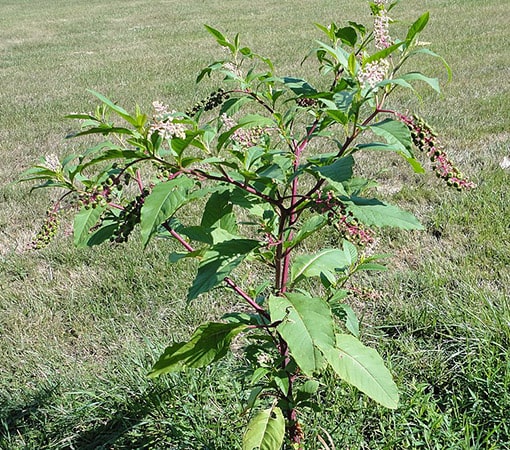
This plant has several other names such as phytolacca Americana, dragon berries, American pokeweed, or poke sallet.
Pokeweed holds a potent toxin, which is extremely poisonous to humans, pets, cattle, and other farm animals. Its fruits look like berries but are also very toxic. However, there are some species of birds and small animals that are immune to this poisonous substance and consume them.
The easiest way to identify pokeweed is by its fruits that look like berries, or similar to a black grape with small rounded grains.
When pokeweed doesn’t carry fruits, you should be able to recognize this plant by its thick purple stems with green-to-white flowers or lance-shaped green leaves.
Because its ability to spread quickly, pokeweed is considered an invasive and harmful weed. It can form dense bushes and overwhelm other plants. Plus, due to its toxicity, it’s a real threat for children, pets, and livestock.
3. Sunflower
Common sunflower is a large annual herbaceous flowering plant generally grown for its seeds. It is a part of Helianthus, a genus including about 70 species of plants.

Everyone has chewed sunflower seeds, but there are many people that cannot identify a sunflower plant without seeing the well-known yellow flowering head that turns after the sun.
There are multiple varieties of sunflowers, some with varying colors for the flower heads and different sizes.
You can usually identify the Sunflower plant by its stem, large rough heart-shaped leaves, and flowering head. The stalk is thick, has a green color, grows upright, and is usually covered by a thin coat of hair.
Besides the production of oil and food, some species of sunflowers are also used as ornamental plants in landscaping.
4. Ricinus
Ricinus (Ricinus communis), also known as the castor bean or castor oil plant, is a fast-growing perennial shrub in the spurge family. It is a plant native to Asia and Africa and grown as an ornamental plant in many parts of the world. Ricinus can reach the size of a small tree, about 12 m (40 ft), in hot climates.
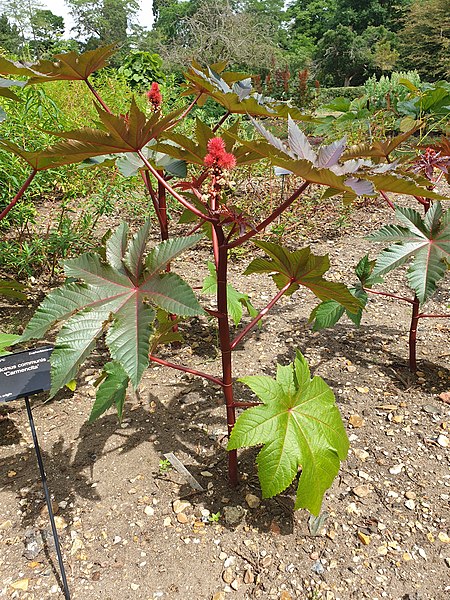
Despite its pleasant appearance, Ricinus is one of the most poisonous plants in the world. All its parts, especially the beans-like-seeds, contain a deadly naturally occurring toxin called “ricin.” Ricin can be lethal for both humans and animals.
You can typically recognize this plant by the following particularities.
Ricinus has a thick stalk, which is usually of a purple-to-reddish color. It has large glossy leaves, similar in shape with an open palm that has about 5 to 11 fingers, with prominent centered veins that unite with the leaf stem. The color of the leaves is typically dark reddish-purple when the plant is young and gradually changes to a dark green when the plant reaches maturity.
Its fruits are spiny green or reddish-purple capsules that contain large, oval, bean-like seeds with different brownish patterns.
Castor bean is considered an invasive plant in several countries, particularly in the tropics.
5. Japanese Knotweed
Japanese knotweed, also known as Asian knotweed, Japanese bamboo, or Reynoutria japonica, is a large perennial plant indigenous to Japan, China, and Korea. It was assumedly introduced to the United States and Europe in the 1800s as an ornamental plant. It became trendy due to its bamboo look and because it didn’t have extraordinarily demanding growing requirements.
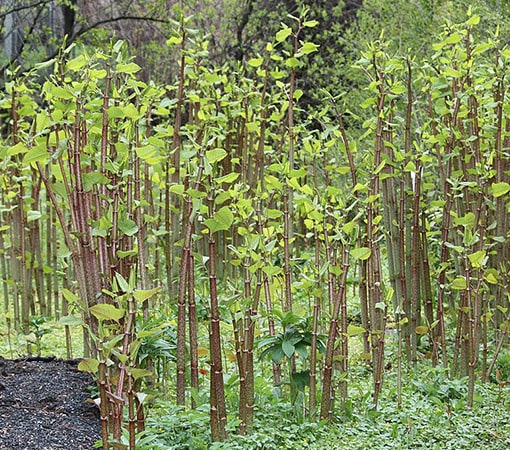
The identification of Japanese knotweed is not always straightforward, especially when they are young. Several other plants can be easily mistaken for being knotweed because of the similar appearance of leaves and stems.
A mature plant has hollow robust stems with distinct raised nodes similar to those of bamboo. These can grow up to 13 ft (4 m) each season.
The leaves of Japanese knotweed are green, oval with a truncated base. The flowers are tiny, white or cream, produced in upright racemes in late summer and early fall.
Japanese knotweed is considered an invasive plant and has been listed on the noxious weeds list of many US states due to the danger it poses for the native plants. It likes to grow in dense bushes, crowding out the native plants and eventually killing them.
6. Wild Lettuce
Wild lettuce is an annual or biennial herb in the family of Asteraceae (same family as dandelions). It is widely considered a weed and is the closest wild relative of cultivated lettuce.

Wild lettuce is native to Europe, North Africa, and Asia, but has quickly spread almost everywhere. There are several varieties of wild lettuce. Two of the most popular are Lactuca virosa and Lactuca serriola.
This weed can reach an impressive size about the maturity time. In the proper climate, it can even grow to 7 or 8 feet (2 – 2.5 m) in height.
The plant develops a single tall stem which becomes more robust once with age. Depending on the variety, it can be sometimes covered with thin spines. The color of the stem usually varies from one species to another, and it can be greyish-green, green, purple, or brownish-red.
The wild lettuce leaves are green, elongated, and have serrated edges (excepting the ones at the bottom of the plant). On the inferior side, they have a strengthened vein along the midline that has spikes on its entire length.
Wild lettuce contains a milky sap that has analgesic and sedative effects.
7. Giant Hogweed
Giant hogweed (scientific name Heracleum mantegazzianum) is a perennial flowering shrub in the family of Apiaceae (same family as carrots). This plant is indigenous to the western Caucasus region of Eurasia. Just like many other weeds, Giant Hogweed has spread as an ornamental plant to numerous countries, and it is now on the noxious weed list of many.
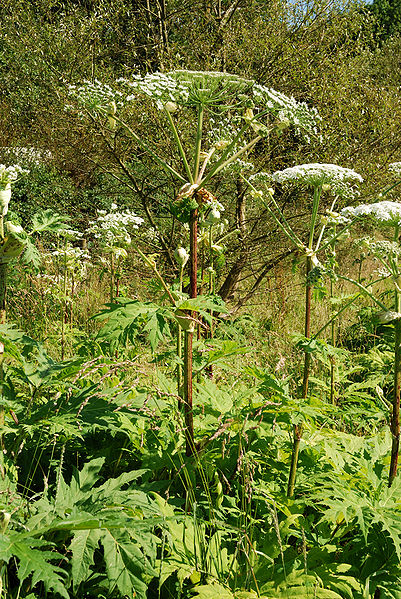
The name “giant hogweed” gives us an excellent representation concerning the growth potential of this plant. Hence, if it has the proper environmental conditions, it can reach even more than 18 ft (5.5 m) in height.
Giant hogweed has a stiff stalk that can grow more than 4 m (13 ft) high and up to 10 cm (3.9 in) in diameter. A mature plant has gigantic incised and intensely lobed leaves that can reach between 1 and 1.5 m (3-4 ft) wide.
This plant is also easily identifiable when it’s in the blooming period due to its sizeable white inflorescence that consists of multiple short flower stalks that spread from a central point, similar to an umbrella.
Because it looks very similar to cow parsnip, a plant from the same family, these two are usually easily mistaken with each other. The difference between these two plants is that giant hogweed grows larger than cow parsnip, has sharper serrated leaves, and has purplish spots on the stalk.
8. Creeping Thistle
Creeping thistle (Cirsium arvense) is a herbaceous perennial plant in the family of Asteraceae with origins in Europe, western Asia, and northern Africa. It later spread to many other regions of the globe.
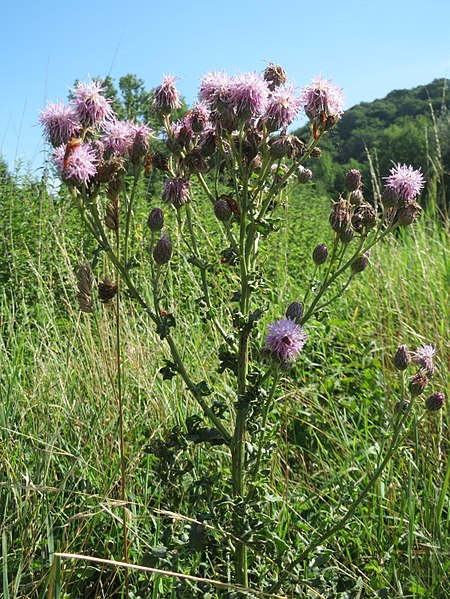
This plant can typically grow up to 1.5 m (5 ft) height, forming vast clonal colonies from the expanded root system that send up several vertical shoots throughout the growing season. Its stalks are smooth, green, branched, and mostly lack spikes. The leaves are typically dark green, lobed, present many thorns, and can grow up to 20 cm long and about 3 cm wide, their size gradually decreasing in the upper part of the plant.
The flowers of creeping thistle are of a pink-purple color, all have a similar form, and are composed of many thin petals.
Because of its adaptive nature and with seeds that are dispersed by winds, the creeping thistle is seen as one of the most invasive weeds globally.
9. Common Mullein
Common mullein (Verbascum thapsus) is a biennial plant original to Europe, Asia, northern Africa, and introduced in the US and other countries.
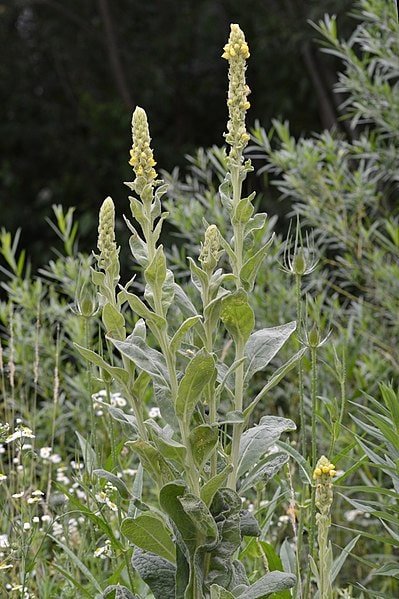
The first thing that can help us to identify this plant is its velvety leaves. Because of this quality of his, some commonly refer to mullein as “cowboy toilet paper.”
During the first year of life, the plant only produces a rosette of leaves on the ground, and only in its second year, it develops a stalk that can grow up to 2 m (6.5 ft) tall. This ends in a dense inflorescence that can occupy up to half of the stem length. The flowers are yellowish and have very short pedicels.
A layer of hair covers all parts of the plant, giving these plants a silvery appearance. However, the densest is found on the surface of the leaves.
Common mullein spreads by prolifically producing seeds, and while it doesn’t represent a problem in many areas, it has become invasive in the temperate climates where it grows the best.
10. Himalayan Balsam
Himalayan balsam (scientific name Impatiens glandulifera) is also commonly known as policeman’s helmet, copper tops, gnome’s hatstand, Ornamental jewelweed, Indian jewelweed, bobby tops, touch-me-not, as well as a few other names.

It is a large annual herbaceous plant native to the Himalayan mountain range in Asia. While this plant can tolerate various types of soils, it habitually prospers on the banks of rivers. However, it can also be found in forests, wetlands, sides of roads, and can even occupy people’s yards or gardens.
Himalayan balsam normally reaches up to 2 m (6.5 ft) high. It has a green or slightly red stem that thickens when the plant reaches maturity. The leaves are lance-shaped with a pointy top. The flowers are typically pink or white, with a hooded shape. Hence, its popular name of “policeman’s helmet.”
After the flowering season, Himalayan balsam forms seed pods that pop when something touches them, dispersing the seeds up to 7 m (23 feet) distance.
Impatiens glandulifera endangers some of the native species of plants and alters the behavior of pollinating insects. Hence, it is regarded as an invasive weed species in many areas.
Final Word
These are ten plants with a tall thick stalk that might pop up in your yard or garden without your allowance. The list could probably go on and on since there are a lot of other weeds that would fit these criteria.
Hopefully, this post will help someone identify a mysterious plant growing in his or her yard one day.
If you still cannot find an enigmatic plant among the ones in this article, I recommend you install a plant identification app (check out my list of best apps here) on your phone and simply take a photo of a leaf or another part of the plant. That should help you recognize the plant in no time.

